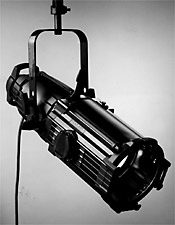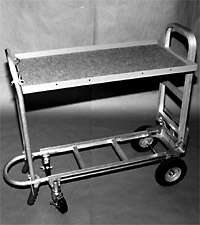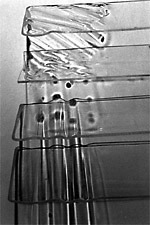Sponsored by:

An extraordinary seminar was held on color theory in the Herberger Theater Stage West, across the street from the convention center. "Designing a Color Palette" was presented by theatrical lighting designers Beverly Simmons, Stan Pressner and Clifton Taylor, with help from the Herberger's technical director, Mark Mettes.
Taylor's presentations stole the show, as he demonstrated his "war of the roses" scenario. Using a white mannequin as a subject, Taylor placed color scrollers on two ellipsoidal spotlights on either side of the stage. Beginning with white (tungsten) light in each instrument, Taylor, added increasingly saturated magenta filters in front of each fixture. He began with the stage left fixture and a lightly saturated magenta, demonstrating the difference between clean tungsten on one side of the mannequin and the light magenta on the other. Then, in the clean fixture, he inserted a deeper-saturated magenta while keeping the stage left fixture the same. The audience blinked as they witnessed their eyes adjusting to read a slight magenta from stage right and "white" light coming from the left. Even though the slightly less saturated magenta filter was still in the left instrument, the eye adjusted to read the less saturated color as "white." Taylor continued alternating deeper and deeper saturations of magenta; with the use of each deeper filter, the previous strength read to the eye as "white." This was an extraordinary real-world example of the eye's adaptability, combined with the brain's color memory to interpret one color as another.
Taylor further shared the theory of dominant and recessive colors, noting that the eye will be attracted first to a dominant color over a recessive color, and that two opposing colors on the same subject will tend to appear primarily as the dominant color. Simmons highlighted her presentation by showing how, in a color saturated environment, the eye begins to see secondaries that aren't necessarily there. A very warm set with warm lighting predominately in the red and yellow range will create a greenish tint in shadows and less illuminated areas, even though no green light is present. A "white" light introduced into this environment will also assume a greenish hue.
Clifton Taylor, website:www.designcurve.com.

Clifton Taylor's Color Diagram, which illustrates dominant and recessive colors according to the theory he presented at an LDI workshop. Adjacent colors are labeled with either a "D" or an "R" signifying dominance or recessive traits. A cyan would be recessive to a blue, hence the two colors on the same subject will take on the traits of the blue over the cyan. Magenta and red are equally dominant compared to one another, just as magenta and blue are equally recessive.
Karl Ruling also presented the "Nebulous Effects" workshop, focusing on modern atmospheric effects, primarily glycol fogs used in "fog-juice" machines from Rosco and Great American Market, among others. A considerable amount of attention has been placed in recent years on the health effects of prolonged exposure to these materials. Gregory Raymond, of The Cohen Group, presented an extensive study compiled in 1993 by the National Institute for Occupational Safety and Health (NIOSH) on the Broadway productions Les Miserables, Miss Saigon and Phantom of the Opera, all of which heavily used glycol fogs for onstage effects.
NIOSH took air samples during rehearsals and performances for analysis. The studies concluded that "prolonged and repeated inhalation of triethylene glycol and propylene glycol concentrations well above those present in high-density fog theatrical productions has been repeatedly demonstrated to not pose a health hazard to human subjects. However, even though propylene glycol is widely used in topically applied cosmetics and pharmaceuticals, it is known to produce allergic skin reactions and/or primary irritation in unusually sensitive individuals."
The workshop also focused on the differences between smoke, which is composed of solid particles suspended in the air (usually as a result of burning or a combustion process), and fog, which is composed of liquid droplets suspended in the air and produced by a variety of processes — just the same as naturally occurring fog.
Most fog machines create a substance made up of a water and glycol combination. Cryogenic fogs, such as those made with liquid nitrogen and solid carbon dioxide (dry ice), are made up of water droplets.
One of the problems in using cryogenic fogs is that both nitrogen and carbon dioxide, when returned to the gaseous state, deplete the oxygen supply in the air, creating a potentially dangerous situation. To combat this effect, James Foley and his partner at the Los Angeles-based company UCISCO created Liquid Synthetic Air, a combination of liquid oxygen and liquid nitrogen which is 100 percent breathable. This breakthrough won the recognition of the AMPAS last year, and UCISCO was presented with an Academy Award for Technical Achievement.
 |
| ETC's new Source Four Zoom fixture. |
Of the many lighting products displayed on the convention showroom floor, two extraordinary highlights were ETC's Source Four Zoom and Cinemills' Rainy Day Par. The idea of a "zoom" spotlight has always been appealing: the flexibility of one fixture with multiple field angle choices. However, light loss and mechanical complication were a high price to pay for convenience.
The Source Four Zoom features crisp imaging, unequaled light output (it is rated for ETC's new high-output HPL 750-watt globe, with the same design as the HPL 575-watt, but is 27 percent brighter), and the company's signature rotating barrel and cool beam.
Further, ETC makes focusing fast and easy. Their engineers watched lighting professionals at work, and responded to professionals' needs. The Source Four Zoom features a revolutionary one-handed focusing mechanism utilizing just a single knob to change the beam angle. The graduated-scale markings on the fixture make it possible to pre-focus the instrument, and — by using the locking lever on the focus mechanism — fix the focus solidly in place. The ETC Source Four Zooms come in two angles: 15 to 30 degrees and 25 to 50 degrees.
Also during the convention, Cinemills Corporation unveiled their new 3-Way 700W/575W/400W, all-weather HMI Par. Complete with a watertight housing and a custom aluminum rain hat, this aerodynamically-designed light head features a specially created reflector that provides extra punch when needed, but the unit can reduce that punch by half for more intimate use.
The maximum output of the CMC 3-Way fixture will provide more spot output than the standard 1200W SE. Its all-new electronic flicker-free world ballast is whisper-quiet and boasts a durable, lightweight construction. The modular assembly features dimmer capabilities in three stages, from 700W to 575W to 400W. This world ballast runs on auto input voltage of 90v to 130v and 180v to 260v AC, with Power Factor Compensation at both 50Hz and 60Hz. The head weighs 12 pounds, and the ballast a mere 5 pounds.
ETC, (608) 831-4116, website: www.etcconnect.com.
Cinemills, (800) 325-7674, website: www.cinemills.com.
Pro-Tapes & Specialties announces Pro-Matte Wrap, a matte-black, opaque aluminum foil. Its pressure-sensitive adhesive backing was specially formulated using solvent-based rather than waterborne materials to provide superior tack. The special formulation permits the ultra-matte black foil to be easily picked up and repositioned without leaving any messy, sticky residue. Because this substance won't burn or melt, it's suitable for a wide range of applications: lighting decorators/engineers can use it to create shadows, form barn doors, adapt gobos, mask light spill and much more. Pro-Matte Wrap aluminum foil can also be ordered without an adhesive backing. The adhesive-backed version is available in 2', 3', 4', 6', and 12' wide by 25' length roles. The non-adhesive version is available in 12" and 24" wide rolls, in both 25' and 50' lengths. The non-adhesive version is boxed in an easy-to-use dispenser, similar to those utilized for kitchen–type aluminum foil. For easy identification, the boxes are conveniently printed on all four sides and on both ends.
Pro-Tapes & Specialties, (800) 345-0234, fax (732) 346-0777, website: www.protapes.com.
In response to demands by professional videographers wanting greater flexibility, creativity and control over the Canon XL-1 digital camcorder, OpTex has created the XLPro 14x 5.5mm manual zoom lens. The XLPro features an aperture of f1.4; a zoom range of 5.5mm-77mm (equivalent 35mm SLR lens: 40-550 mm approx.); a macro facility of 0.5m Minimum Object Distance and will achieve a fixed focal length of 2.75mm when used with the OpTex Multi-coated Wide Angle Adaptor Set.
OpTex, 44 (0)181-441 2199, fax 44 (0)181-449 3646, e-mail: [email protected].

Magliner and Nalpak have announced their new Alumakart, a handcart that is lighter and even more compact than the Magliner Gemini series yet compatable with most Nalpak accessory items. The Alumakart features a standard 36" x 18" aluminum shelf.
Nalpak, (619) 258-1200, fax (800) 258-0925, website: www.nalpak.com.

The Clairmont Distortion filters were created at the request of cameraman Dante Spinotti, ASC, AIC for use while shooting the film Blink. He needed to capture the point of view of someone who had just regained their eyesight after many years of blindness. Spinotti asked Clairmont for a practical alternative to the computer-generated manipulations that had been suggested to create this effect.
Warped Plexiglass proved to be the answer. Clairmont technicians melted and bubbled 6" x 12" sheets in varying degrees. With the companion, custom motorized mattebox, these filters can be slid from side to side or rotated. Cascading streaks of color flow off the subject as the irregular portion of the Plexiglass passes in front of it.
The 6" x 12" motorized mattebox mounts on 15mm rods in front of any lens that is compatable with a 6.6" x 6.6" mattebox. Inclusive with the mattebox package is a motor and control, plus batteries.
Clairmont Camera, Hollywood: (818) 761-4440, fax (818) 761-0861; Toronto: (416) 467-1700, Vancouver: (604) 984-4563.
| [ Previous page ] |
© 1999 ASC